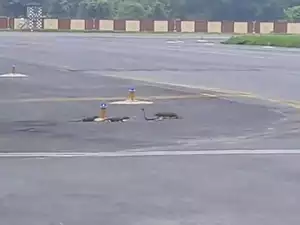
An intense encounter between a cobra and three mongooses unfolded on the runway of Patna Airport, captured in a viral video. The footage shows the snake initially engaged in a one-on-one battle with a mongoose. As the confrontation escalates, two more mongooses join, resulting in a dramatic three-on-one struggle.
Natural Enemies in the Animal Kingdom
#Bihar | Snake vs 3 Mongooses Epic Showdown on Patna Airport Runway | #WATCH#PatnaAirport #Mongoose #Snake #ViralVideo pic.twitter.com/a2FFa4RWXw
— TIMES NOW (@TimesNow) August 12, 2024
The rivalry between snakes and mongooses is rooted in their evolutionary history as natural enemies. Both species have adapted to counter each other in a continuous cycle of attack and defense. Snakes prey on mongooses and their young, while mongooses are known for hunting and eating snakes, making them fierce competitors in the wild.
Competition and Territorialism
The competition for resources such as food, shelter, and territory further intensifies the mongoose-snake rivalry. Both are carnivorous and often compete for the same prey in their habitats. Mongooses are highly territorial and aggressively defend their domains against intruding snakes, which seek to expand their territory for food or shelter. This competition frequently leads to violent clashes, as seen in the recent video.
Another Viral Video Highlights
In another viral video, a snake was spotted flying overhead in Jalalabad, Fazilka, causing widespread panic. The snake, initially mistaken for a long ribbon, glided across the road, surprising onlookers.
Snakes are often feared, and the idea of flying snakes can be terrifying. This phenomenon does exist, particularly in the forests of Asia and Southeast Asia.















